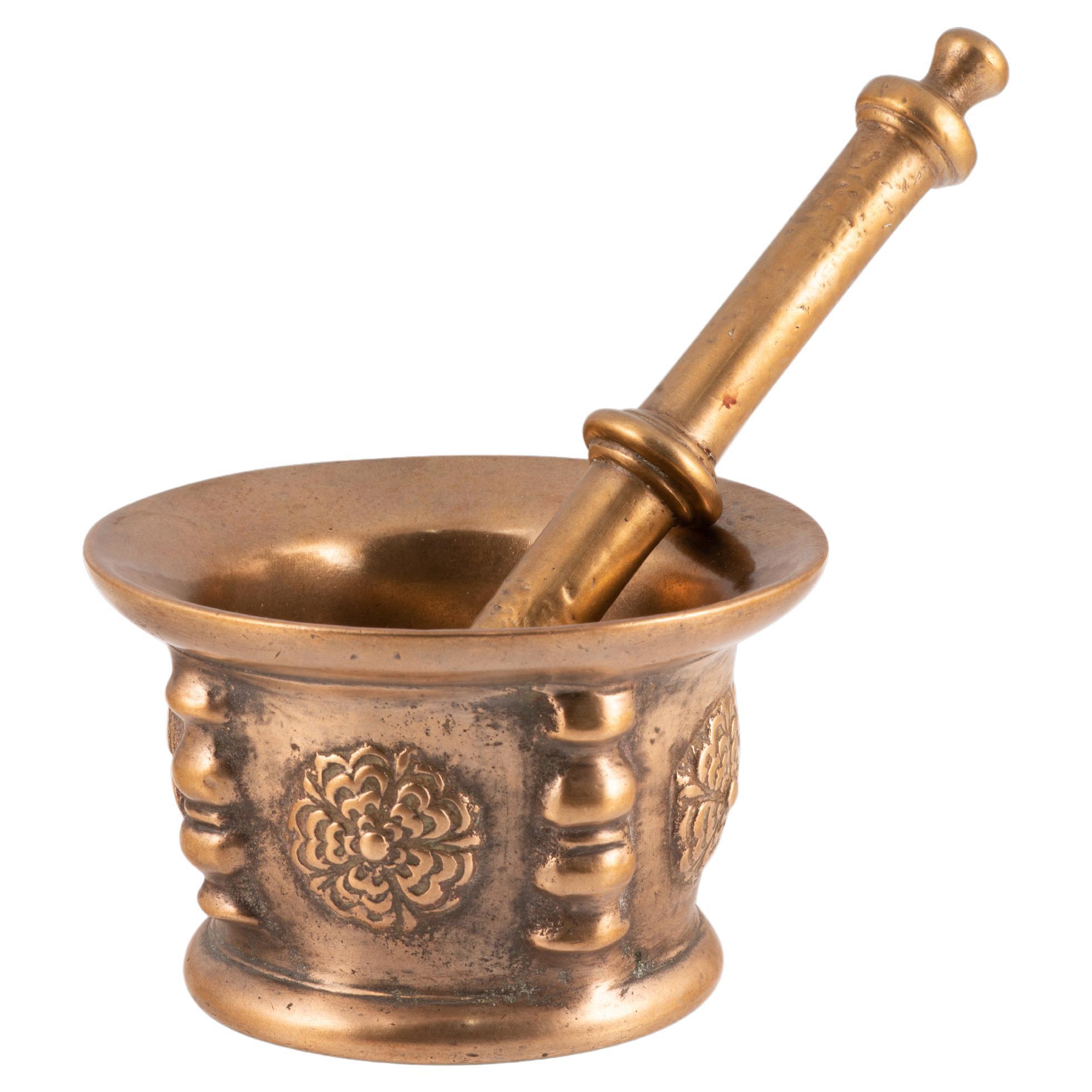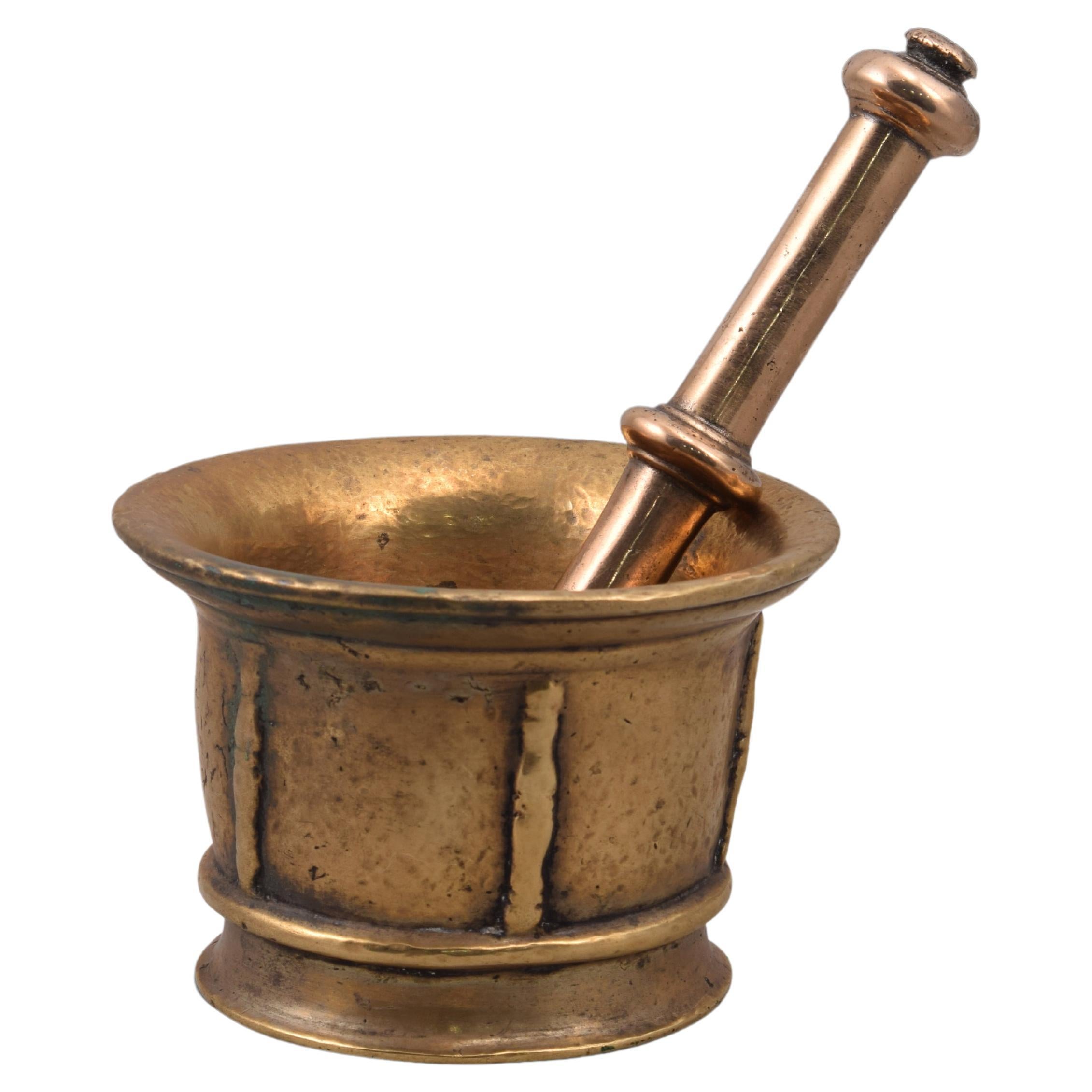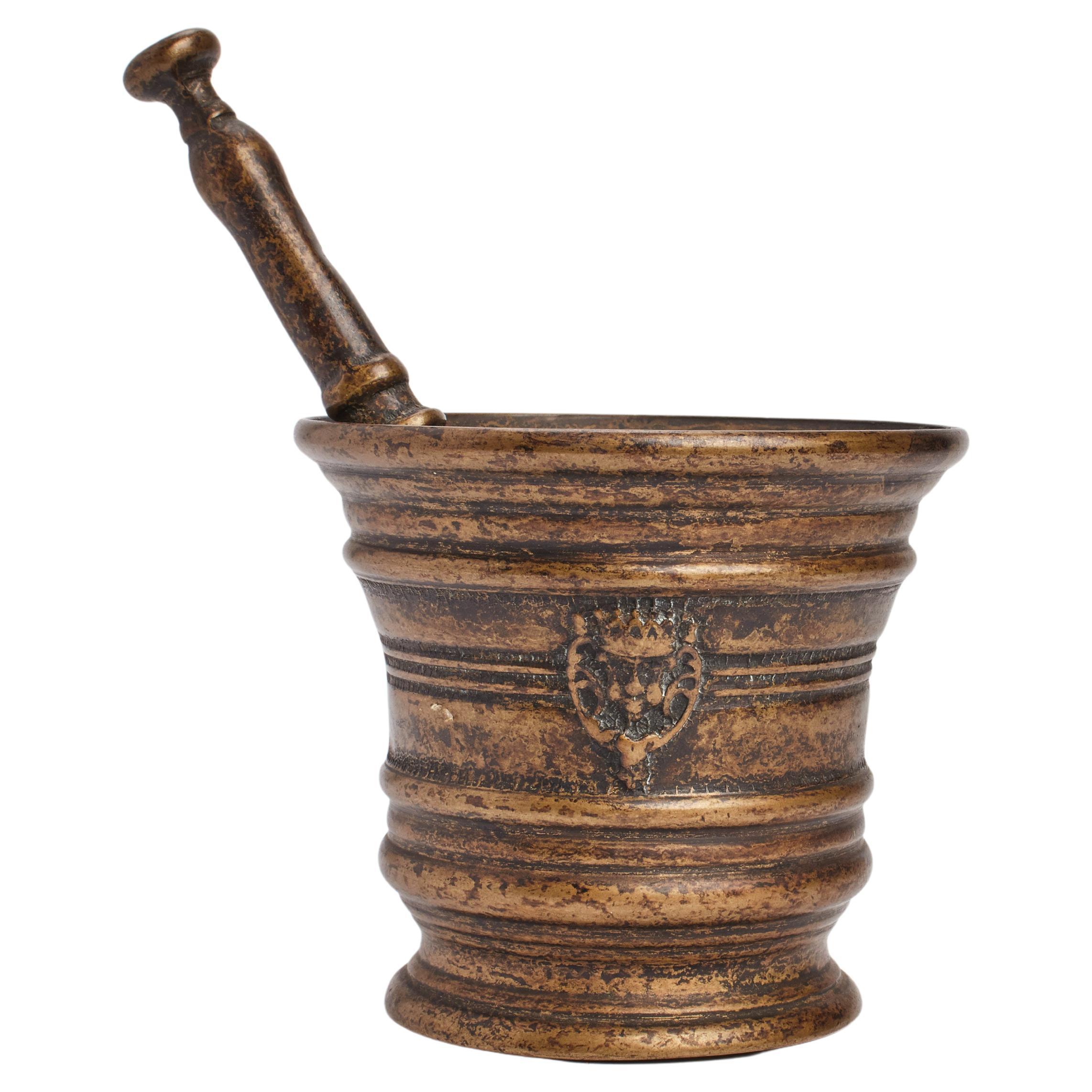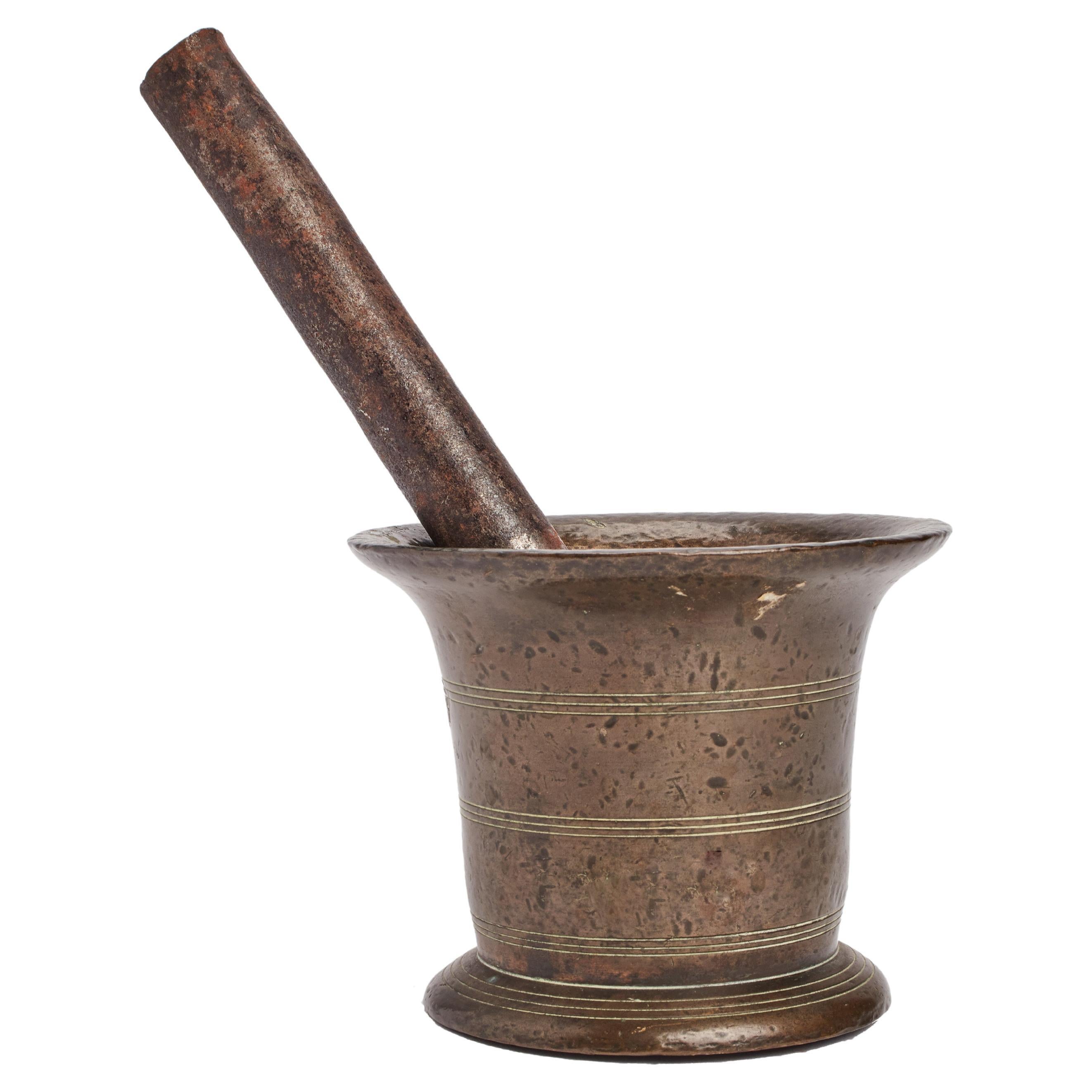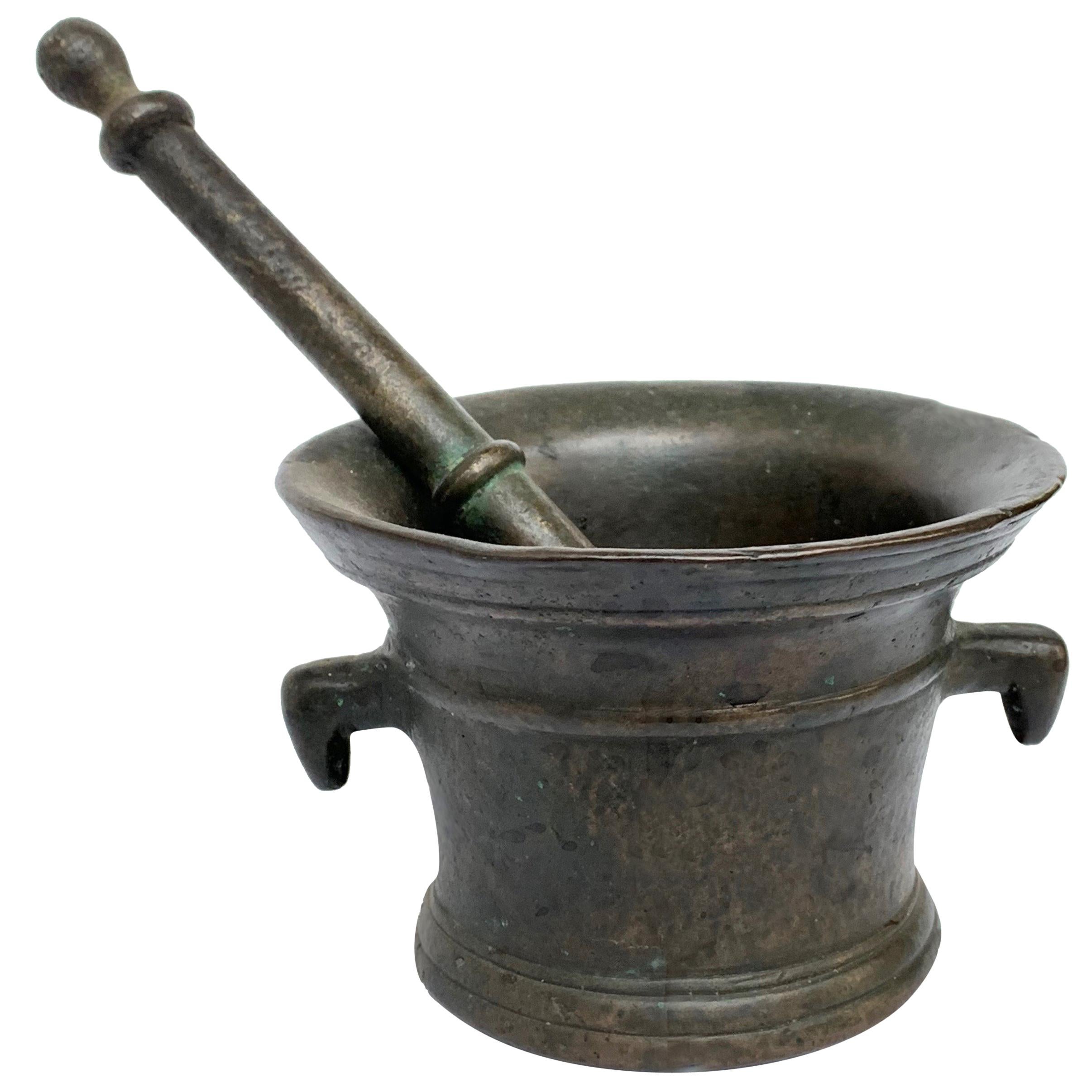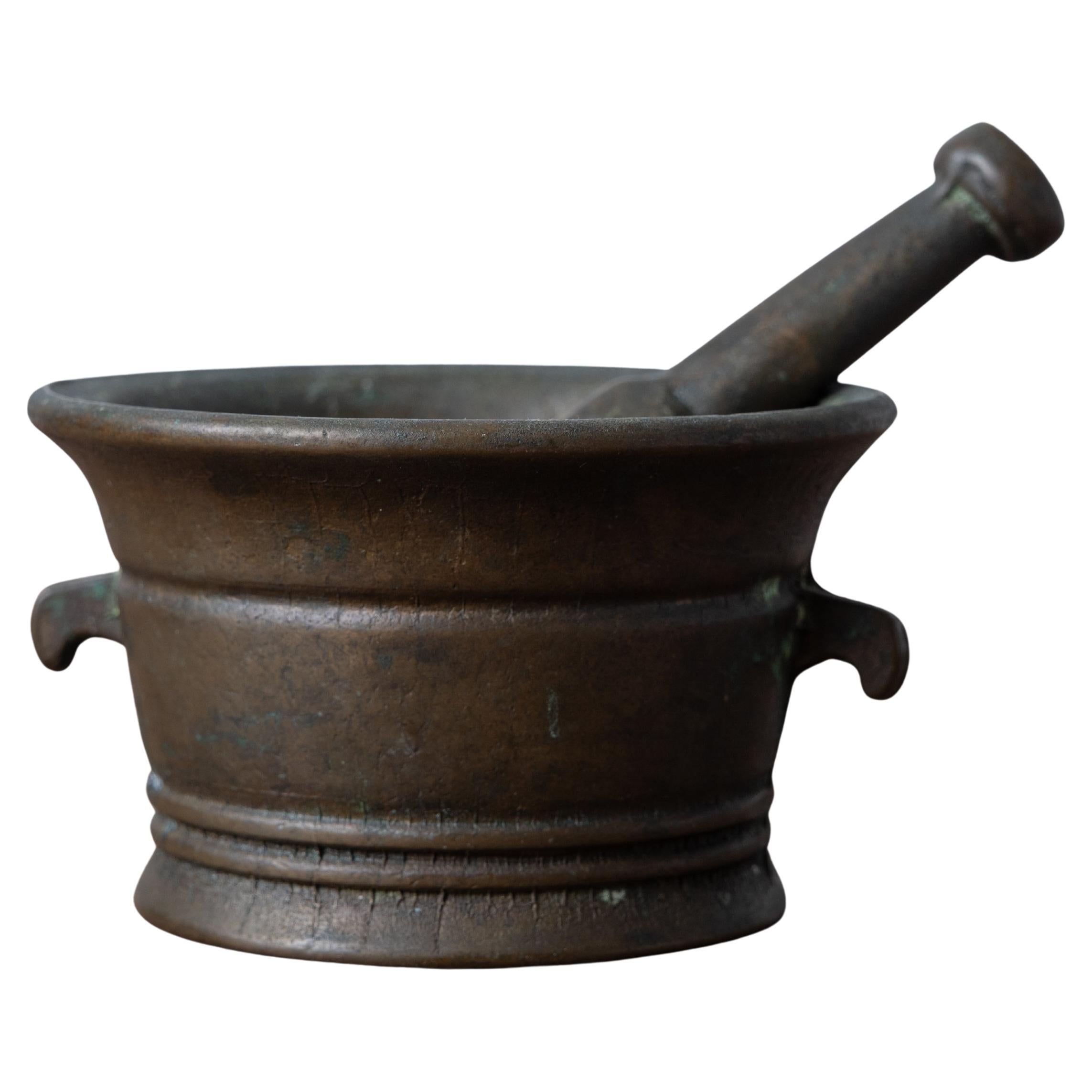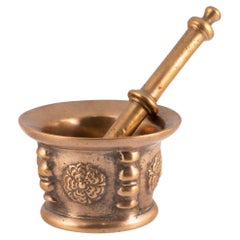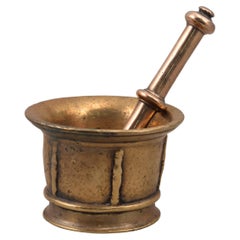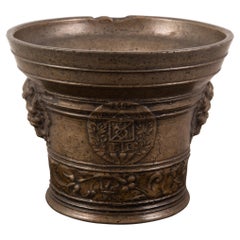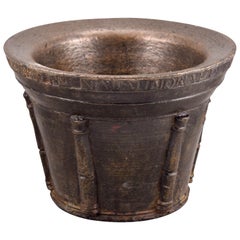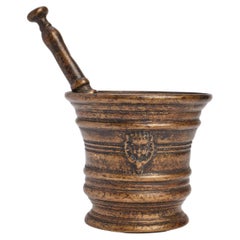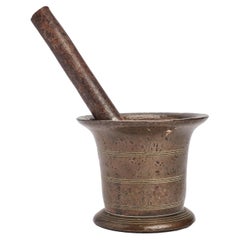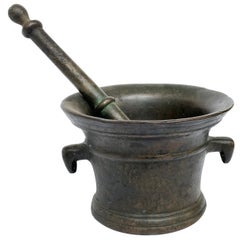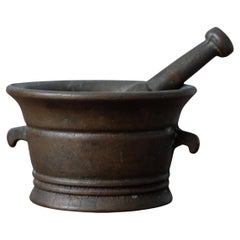Items Similar to Mortar and pestle. Bronze. 15th century.
Want more images or videos?
Request additional images or videos from the seller
1 of 10
Mortar and pestle. Bronze. 15th century.
$1,319.93
£973.39
€1,100
CA$1,822.81
A$2,000.05
CHF 1,046.74
MX$24,613.89
NOK 13,187.29
SEK 12,351.86
DKK 8,377.85
About the Item
Mortar and pestle. Bronze. 15th century.
Bronze mortar and pestle with a circular base and a spouted mouth decorated with a band beneath the rim. The base, facing outward, features three smooth lines in relief, above which appears a decoration framed by a band at the top consisting of heavily worn elements or masks over Gothic-style calligraphy. Reminiscent of French pieces held in private collections.
Weight: 2.8 kg. · Size: 13x13x9.5 cm
International Buyers – Please Note: for those articles that need Export Permits (those older than 100 years), the obtaining of the Permit will be processed without additional expenses (if you choose the seller sends it to you), but the period for the obtention of it may vary from 10 to 35 days.
- Dimensions:Height: 3.75 in (9.5 cm)Width: 5.12 in (13 cm)Depth: 5.12 in (13 cm)
- Style:Gothic (Of the Period)
- Materials and Techniques:
- Place of Origin:
- Period:
- Date of Manufacture:15th century
- Condition:Wear consistent with age and use. Minor fading. Check pictures, sold as it is.
- Seller Location:Madrid, ES
- Reference Number:Seller: ZF14011stDibs: LU2951344468032
About the Seller
4.9
Vetted Professional Seller
Every seller passes strict standards for authenticity and reliability
Established in 1985
1stDibs seller since 2017
350 sales on 1stDibs
Typical response time: 18 hours
- ShippingRetrieving quote...Shipping from: MADRID, Spain
- Return Policy
Authenticity Guarantee
In the unlikely event there’s an issue with an item’s authenticity, contact us within 1 year for a full refund. DetailsMoney-Back Guarantee
If your item is not as described, is damaged in transit, or does not arrive, contact us within 7 days for a full refund. Details24-Hour Cancellation
You have a 24-hour grace period in which to reconsider your purchase, with no questions asked.Vetted Professional Sellers
Our world-class sellers must adhere to strict standards for service and quality, maintaining the integrity of our listings.Price-Match Guarantee
If you find that a seller listed the same item for a lower price elsewhere, we’ll match it.Trusted Global Delivery
Our best-in-class carrier network provides specialized shipping options worldwide, including custom delivery.More From This Seller
View AllMortar and pestle. Bronze. 19th century.
Located in Madrid, ES
Mortar and pestle. Bronze. 19th century.
Mortar with a flared mouth and relief decoration on the exterior based on balustraded elements (reminiscent of the ribs that these objects ...
Category
Antique 19th Century European Other Scientific Instruments
Materials
Bronze
$359 / set
Bronze Mortar with Pestle, Spain, 17th Century
Located in Madrid, ES
Mortar with hand. Bronze. XVII century.
Mortar with a circular base, cylindrical body and slightly outwardly flared mouth, decorated with a series of smooth horizontal moldings arranged both in the lower and upper areas and with simple vertical elements (which still maintain slight balustraded shapes) derived from of the ribs that these specimens used to have in the medieval Spanish...
Category
Antique 17th Century Spanish Baroque Scientific Instruments
Materials
Bronze, Other
Flemish mortar. Bronze. 17th century.
Located in Madrid, ES
Flemish mortar. Bronze. XVII century.
Features brand.
Mortar with a circular base with a mouth that extends outward from the two upper stripes and a body with slight entasis and a ...
Category
Antique 17th Century European Baroque Scientific Instruments
Materials
Bronze
Bronze Mortar with Inscription, Spain, 1816
Located in Madrid, ES
Pharmacy mortar. Bronze. Spain, 1816.
Mortar with an excavated mouth, decoration of derived ribs in pilasters and a stripe in the upper area with an inscription (I am from Don Juan Antonio...
Category
Antique 1810s Spanish Neoclassical Revival Scientific Instruments
Materials
Bronze
Iron pharmacy mortar. 18th-19th centuries.
Located in Madrid, ES
Iron pharmacy mortar. 18th-19th centuries.
Old mortar for pharmaceutical use, made of cast iron. It follows the usual structure for this type of utensil between the 15th and 19th ce...
Category
Antique 19th Century Spanish Neoclassical Revival Scientific Instruments
Materials
Iron
Mortar with Inscriptions. Bronze, Spain, 1823
Located in Madrid, ES
Mortar with inscriptions. Bronze. Spain, 1823.
Con maza.
Mortar made of bronze with an enlarged mouth and a cone shaped body developed without discontinuity and with a decreasing diameter to the base; It has two handles or "pieces" towards the smooth decorative moldings that it has on the upper part. The piece presents, almost on the edge, an inscription (I AM FROM D GREGORIO OCANA ANO DE 1823) in capital letters and a date in roman with spaces between them; and the text (the other way around) “Mazon fecci”; both flanked by a simple molding above and another below.
This large-sized mortar is of the type that is usually known as "hospital" because it is usually used for medicines in environments with many patients or in important apothecaries. Typologically, it follows the usual line in these examples of the Spanish school during the 19th century: smooth, with moldings and, as a general rule, without those ribs (or derivatives thereof) that used to appear in the previous ones. Compare, for example, with the large pharmacy mortar in the Municipal Museum-Archive of Calella (with inscription, ribs and human heads as handles), a large pestle...
Category
Antique 1820s Spanish Neoclassical Revival Scientific Instruments
Materials
Bronze
You May Also Like
An apothecary bronze mortar and pestle, Italy 1700.
Located in Milan, IT
Bronze Apothecary mortar, fitted with mortar pestle. Italy early 18th century.
Category
Antique Early 18th Century Italian Scientific Instruments
Materials
Bronze
An apothecary bronze mortar and pestle, Italy 1700.
Located in Milan, IT
Bronze Apothecary mortar, fitted with mortar pestle. Italy early 18th century.
Category
Antique Early 18th Century Italian Scientific Instruments
Materials
Bronze
Italian Bronze Mortar and Pestle, Original Patina, Italy, Pharmacy or Herbalist
Located in Roma, IT
Antique bronze mortar. Handmade with pestle. Original patina
Mortar from pharmacy or herbalist.
Italian bronze mortar and pestle
Measure: Pe...
Category
Antique Mid-19th Century Italian Other Scientific Instruments
Materials
Bronze
Italian Bronze Mortar & Pestle
Located in Savannah, GA
An Italian bronze mortar and pestle, 18th century.
3 ¾ inches wide by 3 ⅜ inches deep by 2 inches tall
Category
Antique 18th Century Italian Decorative Dishes and Vide-Poche
Materials
Bronze
An apothecary bronze mortar and pestle, Italy 1700.
Located in Milan, IT
Bronze Apothecary mortar, fitted with mortar pestle. Italy early 18th century.
Category
Antique Early 18th Century Italian Scientific Instruments
Materials
Bronze
Small gilded bronze mortar and pestle, Italy
Located in Cuneo, Italy (CN)
Small antique mortar with original pestle, chiseled in gilded bronze with period decorations, antique pharmacy mortar, used for potions and medicines, beautiful gift idea or to use i...
Category
Antique 19th Century Italian Scientific Instruments
Materials
Brass
More Ways To Browse
Antique Dental Instrument
Antique Medical Devices
Antique Wooden Spools
Apothecary Scales Antique
Black Forest Thermometer
Boxed Boat Compass
Carpentry Tools
Movie Projector
Peugeot Coffee Grinders
Pressure Gauge
Ross London
Surveyors Level
Used Refractor Telescopes
Wheel Barometer
Antique Butcher Scale
Antique Human Bones
Antique Measuring Devices
Antique Planetarium
